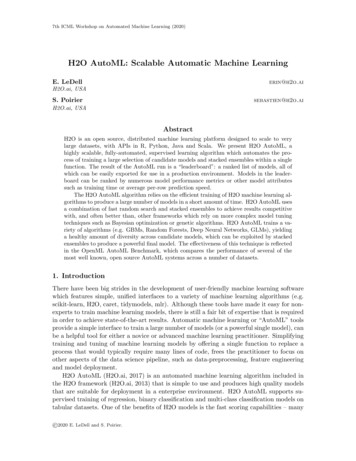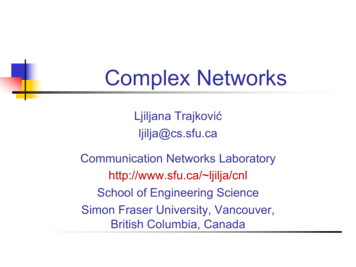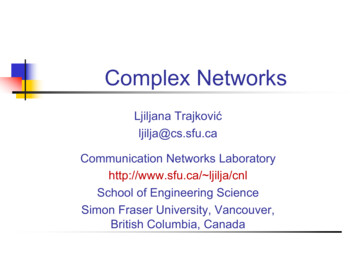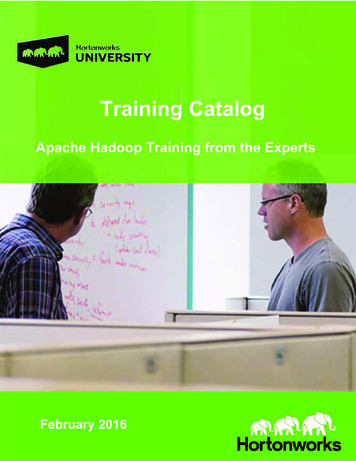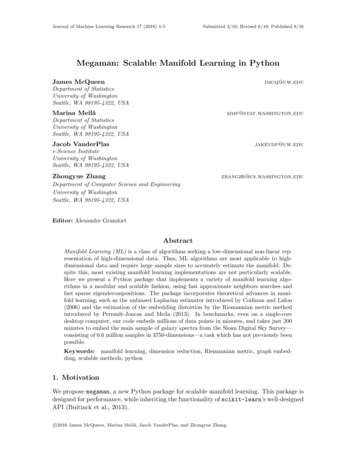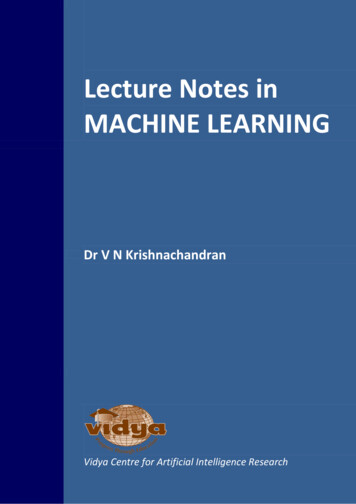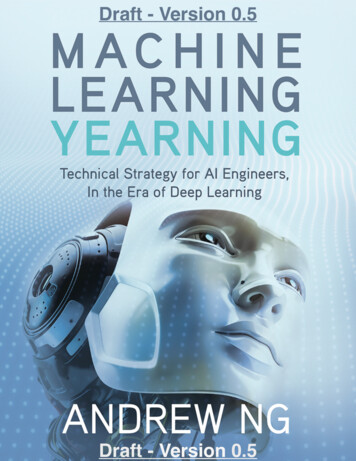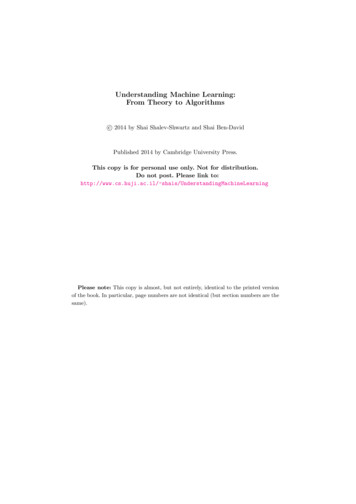
Transcription
MLlib: Scalable Machine Learning on SparkXiangrui MengCollaborators: Ameet Talwalkar, Evan Sparks, Virginia Smith, XinghaoPan, Shivaram Venkataraman, Matei Zaharia, Rean Griffith, John Duchi,Joseph Gonzalez, Michael Franklin, Michael I. Jordan, Tim Kraska, etc.1
What is MLlib?2
What is MLlib?MLlib is a Spark subproject providing machinelearning primitives: initial contribution from AMPLab, UC Berkeley shipped with Spark since version 0.8 33 contributors3
What is MLlib?Algorithms:! classification: logistic regression, linear support vector machine(SVM), naive Bayes regression: generalized linear regression (GLM) collaborative filtering: alternating least squares (ALS) clustering: k-means decomposition: singular value decomposition (SVD), principalcomponent analysis (PCA)4
Why MLlib?5
scikit-learn?Algorithms:! classification: SVM, nearest neighbors, random forest, regression: support vector regression (SVR), ridge regression,Lasso, logistic regression, ! clustering: k-means, spectral clustering, decomposition: PCA, non-negative matrix factorization (NMF),independent component analysis (ICA), 6
Mahout?Algorithms:! classification: logistic regression, naive Bayes, random forest, collaborative filtering: ALS, clustering: k-means, fuzzy k-means, decomposition: SVD, randomized SVD, 7
LIBLINEAR?Mahout?H2O?Vowpal Wabbit?MATLAB?R?scikit-learn?Weka?8
Why MLlib?9
Why MLlib? It is built on Apache Spark, a fast and generalengine for large-scale data processing. Run programs up to 100x faster thanHadoop MapReduce in memory, or10x faster on disk. Write applications quickly in Java, Scala, or Python.10
Gradient descentww ·nXg(w; xi , yi )i 1val points spark.textFile(.).map(parsePoint).cache()var w Vector.zeros(d)for (i - 1 to numIterations) {val gradient points.map { p (1 / (1 exp(-p.y * w.dot(p.x)) - 1) * p.y * p.x).reduce( )w - alpha * gradient}11
k-means (scala)// Load and parse the data.val data sc.textFile("kmeans data.txt")val parsedData data.map( .split(‘ ').map( .toDouble)).cache()"// Cluster the data into two classes using KMeans.val clusters KMeans.train(parsedData, 2, numIterations 20)"// Compute the sum of squared errors.val cost clusters.computeCost(parsedData)println("Sum of squared errors " cost)12
k-means (python)# Load and parse the datadata sc.textFile("kmeans data.txt")parsedData data.map(lambda line:array([float(x) for x in line.split(' ‘)])).cache()"# Build the model (cluster the data)clusters KMeans.train(parsedData, 2, maxIterations 10,runs 1, initialization mode "kmeans ")"# Evaluate clustering by computing the sum of squared errorsdef error(point):center clusters.centers[clusters.predict(point)]return sqrt(sum([x**2 for x in (point - center)]))"cost parsedData.map(lambda point: error(point)).reduce(lambda x, y: x y)print("Sum of squared error " str(cost))13
Dimension reduction k-means// compute principal componentsval points: RDD[Vector] .val mat RowRDDMatrix(points)val pc mat.computePrincipalComponents(20)"// project points to a low-dimensional spaceval projected mat.multiply(pc).rows"// train a k-means model on the projected dataval model KMeans.train(projected, 10)
Collaborative filtering// Load and parse the dataval data sc.textFile("mllib/data/als/test.data")val ratings data.map( .split(',') match {case Array(user, item, rate) Rating(user.toInt, item.toInt, rate.toDouble)})"// Build the recommendation model using ALSval model ALS.train(ratings, 1, 20, 0.01)"// Evaluate the model on rating dataval usersProducts ratings.map { case Rating(user, product, rate) (user, product)}val predictions model.predict(usersProducts)15
Why MLlib? It ships with Spark asa standard component.16
Out for dinner?! Search for a restaurant and make a reservation. Start navigation. Food looks good? Take a photo and share.17
Why smartphone?Out for dinner?! Search for a restaurant and make a reservation. (Yellow Pages?) Start navigation. (GPS?) Food looks good? Take a photo and share. (Camera?)18
Why MLlib?A special-purpose device may be better at oneaspect than a general-purpose device. But the costof context switching is high: different languages or APIs different data formats different tuning tricks19
Spark SQL MLlib// Data can easily be extracted from existing sources,// such as Apache Hive.val trainingTable sql("""SELECT e.action,u.age,u.latitude,u.longitudeFROM Users uJOIN Events eON u.userId e.userId""")"// Since sql returns an RDD, the results of the above// query can be easily used in MLlib.val training trainingTable.map { row val features Vectors.dense(row(1), row(2), row(3))LabeledPoint(row(0), features)}"val model SVMWithSGD.train(training)
Streaming MLlib// collect tweets using streaming"// train a k-means modelval model: KMmeansModel ."// apply model to filter tweetsval tweets TwitterUtils.createStream(ssc, Some(authorizations(0)))val statuses tweets.map( .getText)val filteredTweets statuses.filter(t model.predict(featurize(t)) clusterNumber)"// print tweets within this particular clusterfilteredTweets.print()
GraphX MLlib// assemble link graphval graph Graph(pages, links)val pageRank: RDD[(Long, Double)] graph.staticPageRank(10).vertices"// load page labels (spam or not) and content featuresval labelAndFeatures: RDD[(Long, (Double, Seq((Int, Double)))] .val training: RDD[LabeledPoint] labelAndFeatures.join(pageRank).map {case (id, ((label, features), pageRank)) LabeledPoint(label, Vectors.sparse(features (1000, pageRank))}"// train a spam detector using logistic regressionval model LogisticRegressionWithSGD.train(training)
Why MLlib? Spark is a general-purpose big data platform. Runs in standalone mode, on YARN, EC2, and Mesos, alsoon Hadoop v1 with SIMR. Reads from HDFS, S3, HBase, and any Hadoop data source. MLlib is a standard component of Spark providingmachine learning primitives on top of Spark. MLlib is also comparable to or even better than otherlibraries specialized in large-scale machine learning.23
Why MLlib? Spark is a general-purpose big data platform. Runs in standalone mode, on YARN, EC2, and Mesos, alsoon Hadoop v1 with SIMR. Reads from HDFS, S3, HBase, and any Hadoop data source. MLlib is a standard component of Spark providingmachine learning primitives on top of Spark. MLlib is also comparable to or even better than otherlibraries specialized in large-scale machine learning.24
Why MLlib? Scalability Performance User-friendly APIs Integration with Spark and its other components25
Logistic regression26
Logistic regression - weak scaling4000103000walltime (s)relative walltime8MLbaseMLlibVWIdeal642000n 6K, d 160Kn 12.5K, d 160Kn 25K, d 160Kn 50K, d 160Kn 100K, d 160Kn 200K, d 160K10002005101520# machines25300MLbaseMLlibVWMatlabFig. 6: Weak scaling for logistic regressionFull dataset: 200K images, 160K dense features.MLbase Similar weak scaling.VWIdeal MLlib within a factor of 2 of VW’s wall-clock time. 3530speedup25201527
wa005101520# machines25301000Logistic regression - strong scalingig. 6: Weak scaling for logistic regression0VWMatlabFig. 5: Walltime for weak scaling for logistic regress35MLlibMLbaseVWIdeal301400120025walltime (s)1000speedupMLbase20158001 Machine2 Machines4 Machines8 Machines16 Machines32 Machines6004001020050005101520# machines2530MLbaseMLlibVWMatlabFig. 7: Walltime for strong scaling for logistic regress8: Strong scalingfor logisticregression FixedDataset:50K images, 160K dense features.with respectto computation. In practice, we see compMLlib exhibits better scalingproperties.scaling results as more machines are added. MLlib is faster than VW with 16 and 32 machines.SystemLines of CodeIn MATLAB, we implement gradient descent insteSGD, as gradient descent requires roughly the same nuMLbase32of numeric operations as SGD but does not requirean28GraphLab383loop to pass over the data. It can thus be implemented
Collaborative filtering29
Collaborative filtering ?30Recover a ra-ng matrix from asubset of its entries.
ALS - wall-clock time SystemWall- ‐clock /me 1Dataset: scaled version of Netflix data (9X in size).Cluster: 9 machines.MLlib is an order of magnitude faster than Mahout.MLlib is within factor of 2 of GraphLab.31
Implementation of k-meansInitialization: random k-means k-means
Implementation of k-meansIterations: For each point, find its closest center.cj k22li arg min kxij Update cluster centers.Pi,li jcj Pi,li jxj1
Implementation of k-meansThe points are usually sparse, but the centers are most likely to bedense. Computing the distance takes O(d) time. So the timecomplexity is O(n d k) per iteration. We don’t take any advantage ofsparsity on the running time. However, we havekx2ck2 2kxk2 2kck22hx, ciComputing the inner product only needs non-zero elements. So wecan cache the norms of the points and of the centers, and then onlyneed the inner products to obtain the distances. This reduce therunning time to O(nnz k d k) per iteration."However, is it accurate?
Implementation of ALS broadcast everything data parallel fully parallel35
Alternating least squares (ALS)36
Broadcast everything Master loads (small)data file and initializesmodels. Master broadcastsdata and initialmodels. At each iteration,updated models arebroadcast again. Works OK for smalldata. Lots ofcommunicationoverhead - doesn’tscale well.RatingsMovie!FactorsUser!FactorsMasterWorkers
Data parallelRatingsMovie!Factors Workers load dataRatings At each iteration,updated models arebroadcast againMuch better scalingRatings Works well for smallermodels. (low K)User!FactorsRatingsMaster38WorkersMaster broadcastsinitial modelsWorks on largedatasets
Fully s Workers load data At each iteration,models are shared viajoin between workers. Much betterscalability. Works on largedatasetsModels areinstantiated atworkers.
Implementation of ALS broadcast everything data parallel fully parallel block-wise parallel Users/products are partitioned into blocks and join isbased on blocks instead of individual user/product.40
New features for v1.x Sparse data Classification and regression tree (CART) SVD and PCA L-BFGS Model evaluation Discretization41
ContributorsAmeet Talwalkar, Andrew Tulloch, Chen Chao, Nan Zhu, DB Tsai, EvanSparks, Frank Dai, Ginger Smith, Henry Saputra, Holden Karau,Hossein Falaki, Jey Kottalam, Cheng Lian, Marek Kolodziej, MarkHamstra, Martin Jaggi, Martin Weindel, Matei Zaharia, Nick Pentreath,Patrick Wendell, Prashant Sharma, Reynold Xin, Reza Zadeh, SandyRyza, Sean Owen, Shivaram Venkataraman, Tor Myklebust, XiangruiMeng, Xinghao Pan, Xusen Yin, Jerry Shao, Ryan LeCompte42
Interested? Website: http://spark.apache.org Tutorials: http://ampcamp.berkeley.edu Spark Summit: http://spark-summit.org Github: https://github.com/apache/spark Mailing lists: user@spark.apache.orgdev@spark.apache.org43
Spark is a general-purpose big data platform. Runs in standalone mode, on YARN, EC2, and Mesos, also on Hadoop v1 with SIMR. Reads from HDFS, S3, HBase, and any Hadoop data source. MLlib is a standard component of Spark providing machine learning primitives on top of Spark
